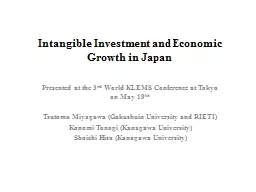PPT-Intangible Investment and Economic Growth in Japan
Author : tatyana-admore | Published Date : 2016-05-14
Presented at the 3 rd World KLEMS Conference at Tokyo on May 19 th Tsutomu Miyagawa Gakushuin University and RIETI Konomi Tonogi Kanagawa University Shoichi
Presentation Embed Code
Download Presentation
Download Presentation The PPT/PDF document "Intangible Investment and Economic Growt..." is the property of its rightful owner. Permission is granted to download and print the materials on this website for personal, non-commercial use only, and to display it on your personal computer provided you do not modify the materials and that you retain all copyright notices contained in the materials. By downloading content from our website, you accept the terms of this agreement.
Intangible Investment and Economic Growth in Japan: Transcript
Download Rules Of Document
"Intangible Investment and Economic Growth in Japan"The content belongs to its owner. You may download and print it for personal use, without modification, and keep all copyright notices. By downloading, you agree to these terms.
Related Documents














